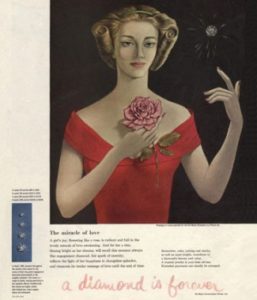Understanding where the aspects of the advertisement industry originate is quite intriguing given the role that advertisements have on popular culture and society as a whole. I could always see that women were deemed as “consumers” by the advertisement world given the commonly held notion that women like to shop, and men do not; whereas, men have always believed they need to be the ‘man of the house’ so-to-speak and be the breadwinner for the family. Growing up I always found this idea to be a bit ridiculous for two reasons. The first being I am a man, and I like to shop. The second being that my mother was the breadwinner in my family and was the producer, provider, and consumer not just one thing. Many of my friends who lived in single-parent households understood this as well, the socially constructed idea of gender is just that, socially constructed.
“Nature was controlled by men who were smart enough to exploit its resources for production, whereas women were privileged as the primary consumers responsible for the health of families and the maintenance of new standards of beauty and glamour.”
In my mind, the semiotics of gender, male, female, and intersex all differ greatly, though intersex is often unrepresented even in our society today. For reasons I do not fully grasp myself it seems that most of this is due to categorization and unawareness. As Hill and Helmers stated, men have the power, and women are given the opportunity to consume because of men. It seems that advertisements just proliferate gender and class struggle simultaneously by telling people what they ought to hold as ‘the ideal family’ or ‘American dream’ in their heads. Obviously, in order to advertise something, you must market it to a targeted group and categorize that group because you want the people in that group to buy it and get another advertisement contract to make more money. However, as we have seen in the past with practically any group this is how some stereotypes are created and some stereotypes are exacerbated.
The way advertisements have been marketed toward people, specifically women and men as aligns with the gender roles they established, have backfired occasionally. One that comes to mind is the diamond market. It only became common for men to buy women a diamond ring within the last century or so, due to advertising by using the social norm that the man must propose to the woman. Their advertisement slogan “A diamond is forever” (photograph below of this ad) was hugely successful but this was only in one aspect, engagement rings. Due to their marketing strategy diamonds were given the social construction of being for women from men for a wedding ring. This made it nearly impossible to sell diamonds to men or even to get women to buy their own diamond rings. While consumerism played a huge role in their first ploy to increase sales, because of their use of gender they could no longer push consumerist rhetoric other than to increase the diamond size a man would buy for his fiancée.
I find this commonplace established by the editors is quite brilliant and insightful because it will be useful come time to analyze any advertisement in the future. It seems that gender will always be present in advertising in some capacity, and this reading has given me a few strategies for analysis and what to look for. Since our reading and introduction to semiotics, analysis has seemed a tad easier and definitely useful in the assertion of claims.
